A Study on Integrating Production Efficiency and Allocation Efficiency into Economic Efficiency Based on the Value Chain—A Case Study of the Dongting Lake Region
Abstract
1. Introduction
2. Overview of the Study Area
3. Methodology, Indicators and Data
3.1. Two-Stage Dynamic Network SBM Model
- (1)
- Production possibility set
- (2)
- Objective function
- (3)
- Period efficiency
- (4)
- Division efficiency
3.2. Malmquist Productivity Index
- (1)
- Divisional catch-up efficiency index (DCU)
- (2)
- Divisional frontier-shift effect index (DFS)
- (3)
- Divisional Malmquist index (DMI)
- (4)
- Dynamic Networks (DN)—Total Factor Productivity (TFP)
3.3. Indicators and Data
3.3.1. System of Indicators
3.3.2. Data and Sources
4. Results and Analysis
4.1. DN-SBM Efficiency Analysis
4.1.1. Efficiency Analysis of the Production Stage
4.1.2. Efficiency Analysis of the Allocation Stage
4.1.3. Dynamic Economic Efficiency Analysis
4.2. Dynamic Network Total Factor Productivity (DN-TFP) Analysis
5. Discussion
5.1. Management Decision Matrix
5.2. Agricultural Production Value Chain
5.3. Policy Implications
6. Conclusions
- (1)
- Economic efficiency has time heterogeneity. The overall trend of total economic efficiency from 2005 to 2020 showed a decline first and then an increase. The overall efficiency of the production stage showed a slight downward trend, and the efficiency value of the allocation stage showed a slight upward trend; however, the efficiency value of this stage was still low. The overall productivity of agricultural production demonstrated a decreasing trend, with approximately 62% of the region experiencing a decline in total productivity. The efficiency and productivity of the production stage surpassed those of the allocation stage.
- (2)
- Agricultural productivity is spatially heterogeneous. Taoyuan County had the highest economic efficiency, followed by Huarong County, Dingcheng District, and Junshan District. Conversely, Linxiang City, Yuanjiang City, and Ziyang District exhibited the lowest economic efficiency, which was attributed to inadequate agricultural labor, excessive agricultural machinery utilization, and fertilizer overuse.
- (3)
- Efficiency at the production stage and efficiency at the allocation stage are always positively or negatively correlated, and the different correlations reflect the different situations at the production and allocation stages. When there is a positive correlation between the efficiencies of the production and allocation stages, it is usually characterized by an increase in production with an increase in revenue or a decrease in production with a decrease in revenue; when there is a negative correlation between the efficiencies of the production and allocation stages, it is usually characterized by a decrease in production with an increase in revenue or an increase in production with a decrease in revenue.
- (4)
- The efficiency of the production and configuration stages facilitates our ability to identify weaknesses in the agricultural production process and to make targeted adjustments to different situations. For example, subsidies for arable land should be increased for regions that need to improve production efficiency to address the loss of large numbers of high-quality laborers, while agricultural product output, market demand, and waste avoidance should be improved. Moreover, infrastructure development must be accelerated in areas requiring enhanced allocation efficiency to upgrade farmland water conservancy facilities, urban and rural transportation, and cold chain logistics systems. Such efforts aim to advance the overall enhancement of rural electrification from quantity to quality.
- (5)
- To further enhance the depth and applicability of the research, future efforts should focus on the following aspects: First, it is recommended to incorporate both system variables (such as technological inputs and mechanization levels) and contextual variables (such as climatic conditions, policy environments, and market structures) into the model to construct a more comprehensive analytical framework. This will allow for a more accurate identification of the internal and external factors influencing economic efficiency performance. Second, the current two-stage model can be extended to a multi-stage structure to reveal the efficiency transmission mechanisms and coupling relationships across all stages of the agricultural production-distribution-allocation chain. Multi-stage modeling can not only provide more precise policy targets but also contribute to understanding the intrinsic logic of synergistic evolution within the system, thereby offering more systematic theoretical support and decision-making references for agricultural modernization and rural revitalization strategies.
Author Contributions
Funding
Data Availability Statement
Conflicts of Interest
Correction Statement
Abbreviation
| DLR | Dongting Lake Region |
References
- Cui, H.Y.; Zhu, W.J.; Yu, H.; Long, J.; Liu, Y.F. Calculation of agricultural production efficiency based on a three-stage Data Envelopment Analysis model and analysis of the spatial-temporal characteristics: An example from the Yangtze River Economic Belt. Chin. J. Ecol. Agric. Engl. 2021, 29, 1243–1252. [Google Scholar] [CrossRef]
- Guo, J.H.; Ni, M.; Li, B.Y. Research on Agricultural Production Efficiency Based on Three-Stage DEA Model. Res. Quant. Tech. Econ. 2010, 27, 27–38. [Google Scholar] [CrossRef]
- Liu, J.W.; Li, X.F.; Gao, P.H.; Wang, F.S. Study on Agricultural Production Efficiency and Its Influencing Factors in Hebei Province Based on DEA Model. Northeast Agric. Sci. 2020, 45, 86–91+107. [Google Scholar] [CrossRef]
- Luo, H.P.; Ai, Z.H.; He, Z.W. An Empirical Study on the Spatial Differences and the Evolutionary Trends of the Guarantee Effectiveness of China’s Food Security. J. Yunnan Univ. Financ. Econ. 2020, 36, 3–14. [Google Scholar] [CrossRef]
- Zhang, X.Y.; Meng, J.J.; Wang, J.; Meng, Y. Study on moderate scale of grain management in agricultural area of central plain based on DEA model: A case of wheat-corn rotation in Henan province. J. Henan Norm. Univ. Nat. Sci. Ed. 2020, 48, 18–23+81. [Google Scholar] [CrossRef]
- Du, H.M.; Jiang, L. Research on the Spatial and Temporal Disparity of Agricultural Ecological Efficiency of Dongting Lake Area Based on SE-SBM Model. Ecol. Econ. 2020, 36, 100–106+121. [Google Scholar]
- Feng, Y.J.; Qi, Q.; Han, J.B. Spatiotemporal Evolution and Driving Factors of Agricultural Eco-efficiency in China. Bull. Soil Water Conserv. 2018, 38, 254–262. [Google Scholar] [CrossRef]
- Ye, H.; Pu, L.J. Study on the Cultivated Land Use Efficiency between Different Regions of China and Its Convergence. J. Nat. Resour. 2011, 26, 1467–1474. [Google Scholar]
- Guo, X.N.; Ruan, P. Evaluation and Convergence Analysis of Agricultural Production Efficiency in the Western Reforestation Area in China—Based on Zhijin County in Guizhou Province. Financ. Sci. 2014, 58, 114–124. [Google Scholar]
- Liu, M.B.; Zhang, A.L.; Wen, G.H. Regional differences and spatial convergence in the ecological efficiency of cultivated land use in the main grain producing areas in the Yangtze Region. J. Nat. Resour. 2022, 37, 377–493. [Google Scholar] [CrossRef]
- Abbas, A.; Zhao, C.; Waseem, M.; Ahmed Khan, K.; Ahmad, R. Analysis of energy input–output of farms and assessment of greenhouse gas emissions: A case study of cotton growers. Front. Environ. Sci. 2022, 9, 826838. [Google Scholar] [CrossRef]
- Grassauer, F.; Herndl, M.; Nemecek, T.; Guggenberger, T.; Fritz, C.; Steinwidder, A.; Zollitsch, W. Eco-efficiency of farms considering multiple functions of agriculture: Concept and results from Austrian farms. J. Clean. Prod. 2021, 297, 126662. [Google Scholar] [CrossRef]
- Sarkhosh-Sara, A.; Tavassoli, M.; Heshmati, A. Assessing the sustainability of high-, middle-, and low-income countries: A network DEA model in the presence of both zero data and undesirable outputs. Sustain. Prod. Consum. 2020, 21, 252–268. [Google Scholar] [CrossRef]
- Kord, A.; Payan, A.; Saati, S. Network DEA Models with stochastic data to assess the sustainability performance of agricultural practices: An application for Sistan and Baluchestan Province in Iran. J. Math. 2022, 2022, 1119630. [Google Scholar] [CrossRef]
- Kord, A.; Payan, A.; Saati, S. Sustainability and optimal allocation of human resource of agricultural practices in Sistan and Baluchestan Province based on network DEA. J. Math. Ext. 2021, 15, 1–44. [Google Scholar]
- Mavi, R.K.; Saen, R.F.; Goh, M. Joint analysis of eco-efficiency and eco-innovation with common weights in two-stage network DEA: A big data approach. Technol. Forecast. Soc. Change 2019, 144, 553–562. [Google Scholar] [CrossRef]
- Güney, O.İ. Eco-efficiency in farm management for sustainable agriculture: A two-stage data envelopment analysis in wheat production. Pol. J. Environ. Stud. 2021, 30, 5549–5557. [Google Scholar] [CrossRef]
- Ren, F.R.; Tian, Z.; Chen, H.S.; Shen, Y.T. Energy consumption, CO2 emissions, and agricultural disaster efficiency evaluation of China based on the two-stage dynamic DEA method. Environ. Sci. Pollut. Res. 2021, 28, 1901–1918. [Google Scholar] [CrossRef] [PubMed]
- Fang, Z.; Chiu, Y.H.; Lin, T.Y.; Chang, T.H.; Lin, Y.N. Analysis of natural disasters and energy efficiency in China. Environ. Dev. Sustain. 2024, 26, 10999–11026. [Google Scholar] [CrossRef]
- Lu, C.C.; Lin, I.F.; Lin, T.Y.; Chiu, Y.H. Two-stage dynamic data envelopment analysis measuring the overall efficiency and productivity changes of industry and agriculture in EU countries. J. Clean. Prod. 2023, 382, 135332. [Google Scholar] [CrossRef]
- Shi, Z.; Wu, Y.; Chiu, Y.H.; Wu, F.; Shi, C. Dynamic Linkages among Mining Production and Land Rehabilitation Efficiency in China. Land 2020, 9, 76. [Google Scholar] [CrossRef]
- Huang, K.Y.; Chang, T.H.; Chiu, Y.H.; Yang, C.Y.; Lin, T.Y. Considering climate change and regional differences: An efficiency assessment of coal mine use and land restoration. Nat. Resour. Forum 2023, 47, 578–601. [Google Scholar] [CrossRef]
- Liu, S.S.; Pu, J.F.; Zhang, B.B.; Wang, S. Cultivated land utilization efficiency in Dongting Lake area: Based on a dynamic network two-stage DEA model. J. China Agric. Univ. 2022, 27, 257–269. [Google Scholar]
- Li, Y.; Cen, H.; Lin, T.Y.; Lin, Y.N.; Chiu, Y.H. Sustainable coal mine and coal land development in China. Resour. Policy 2022, 79, 103092. [Google Scholar] [CrossRef]
- Zhou, H.; Xun, X.; Wang, Y.X.; Chen, L.L. Cultivated Land Use Induced Moisture Balance Effect in Dongting Lake Basin in Recent 40 Years. Yangtze River Basin Resour. Environ. 2024, 33, 822–832. [Google Scholar]
- Farrell, M.J. The measurement of productive efficiency. J. R. Stat. Soc. Ser. A Gen. 1957, 120, 253–281. [Google Scholar] [CrossRef]
- Charnes, A.; Cooper, W.W.; Rhodes, E. Measuring the efficiency of decision making units. Eur. J. Oper. Res. 1978, 2, 429–444. [Google Scholar] [CrossRef]
- Banker, R.D.; Charnes, A.; Cooper, W.W. Some models for estimating technical and scale inefficiencies in data envelopment analysis. Manag. Sci. 1984, 30, 1078–1092. [Google Scholar] [CrossRef]
- Färe, R.; Grosskopf, S.; Whittaker, G. Network DEA. Modeling data irregularities and structural complexities in data envelopment analysis. Science 2007, 6, 240. [Google Scholar]
- Tone, K.; Tsutsui, M. Dynamic DEA: A slacks-based measure approach. Omega 2010, 38, 145–156. [Google Scholar] [CrossRef]
- Tone, K.; Tsutsui, M. Dynamic DEA with network structure: A slacks-based measure approach. Omega 2014, 42, 124–131. [Google Scholar] [CrossRef]
- Malmquist, S. Index numbers and indifference surfaces. Trab. Estadística 1953, 4, 209–242. [Google Scholar] [CrossRef]
- Fáre, R.; Grosskopf, S.; Roos, P. The Malmquist Total Factor Productivity Index: Some Remarks; CESifo Working Paper Series 94; CESifo: Munich, Germany, 1995. [Google Scholar]
- Caves, D.W.; Christensen, L.R.; Diewert, W.E. The economic theory of index numbers and the measurement of input, output, and productivity. Econom. J. Econom. Soc. 1982, 50, 1393–1414. [Google Scholar] [CrossRef]
- Mehrabian, A.; Khalili-Damghani, K.; Amirkhan, M. A Dynamic Network Data Envelopment Analysis Model to Calculate the Efficiency of Wheat Farms. J. Appl. Dyn. Syst. Control. 2023, 6, 29–43. [Google Scholar]
- Xinhua News Agency. Outline of the National Land Use General Plan. 2008. Available online: https://www.gov.cn/guoqing/2008-10/24/content_2875234.htm (accessed on 23 May 2024).
- Hunan Provincial Bureau of Statistics. Hunan Provincial Statistical Yearbook (2005–2020); China Statistics Press: Beijing, China, 2020. [Google Scholar]
- Porter, M.E. Competitive Advantage: Creating and Sustaining Superior Performance; Simon Schuster: New York, NY, USA, 1985; Volume 24, pp. 32–37. [Google Scholar]
- Ghate, P.B. Interaction between the formal and informal financial sectors: The Asian experience. World Dev. 1992, 20, 859–872. [Google Scholar] [CrossRef]
- Muflikh, Y.N.; Smith, C.; Aziz, A.A. A systematic review of the contribution of system dynamics to value chain analysis in agricultural development. Agric. Syst. 2021, 189, 103044. [Google Scholar] [CrossRef]
- Liu, G.Y.; He, P.; Wang, Y.Y. Agro-ecological product and its value realization pathway. J. Appl. Ecol. 2021, 32, 737–749. [Google Scholar]
- Yu, M.M. Capacity efficiency measurement using a three-stage DEA approach: Evidence from domestic airports in Taiwan. Transp. Plan. Technol. 2010, 33, 221–235. [Google Scholar] [CrossRef]
- Xu, B.; Lu, Z.Y.; Yang, S.S.; Yin, P.; Yang, L.L.; Mo, J.L. Spatio-temporal Evolution Pattern and Influencing Factors of Agricultural Production Efficiency in Hunan Province. Econ. Geogr. 2022, 42, 141–149. [Google Scholar]


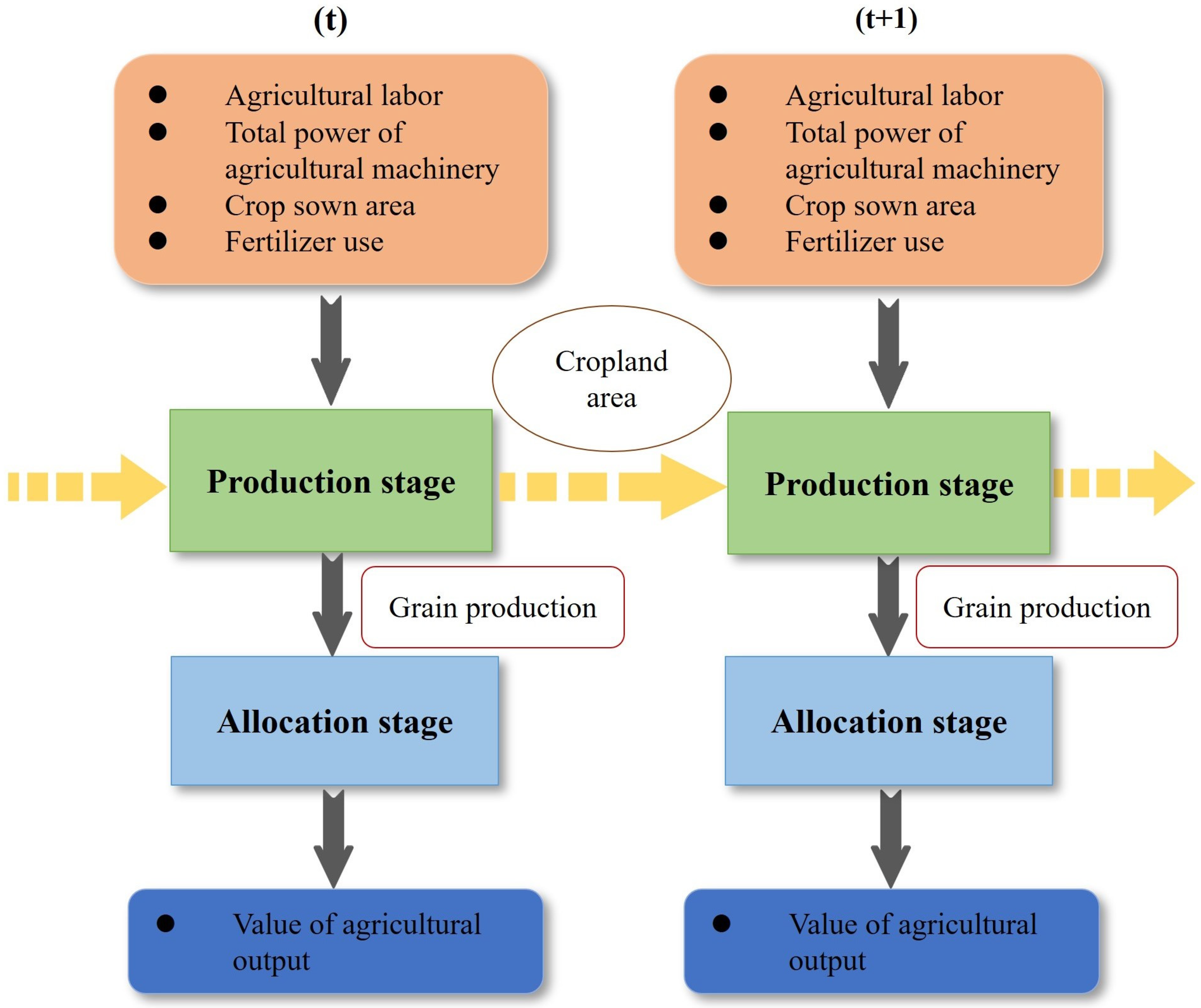
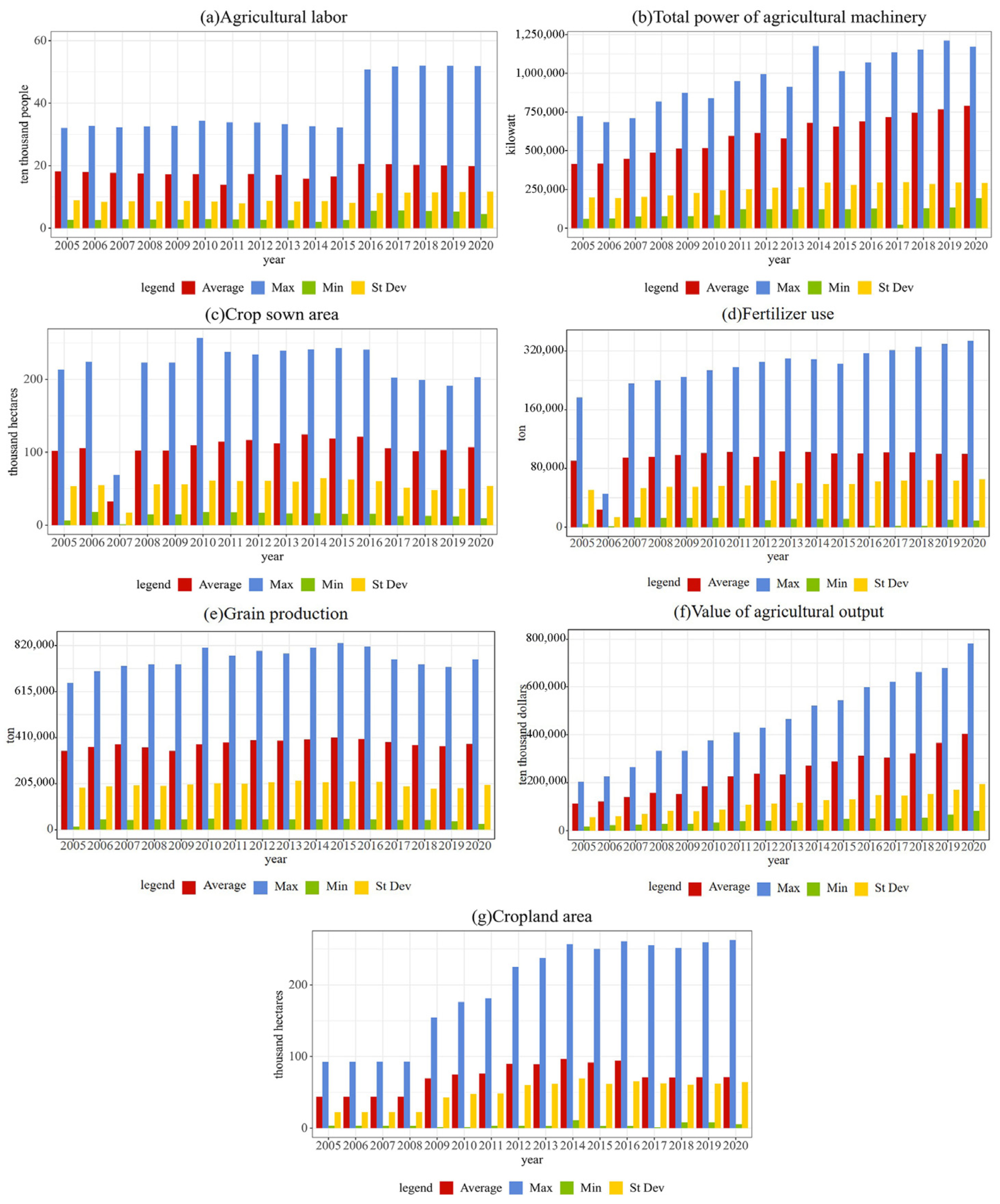
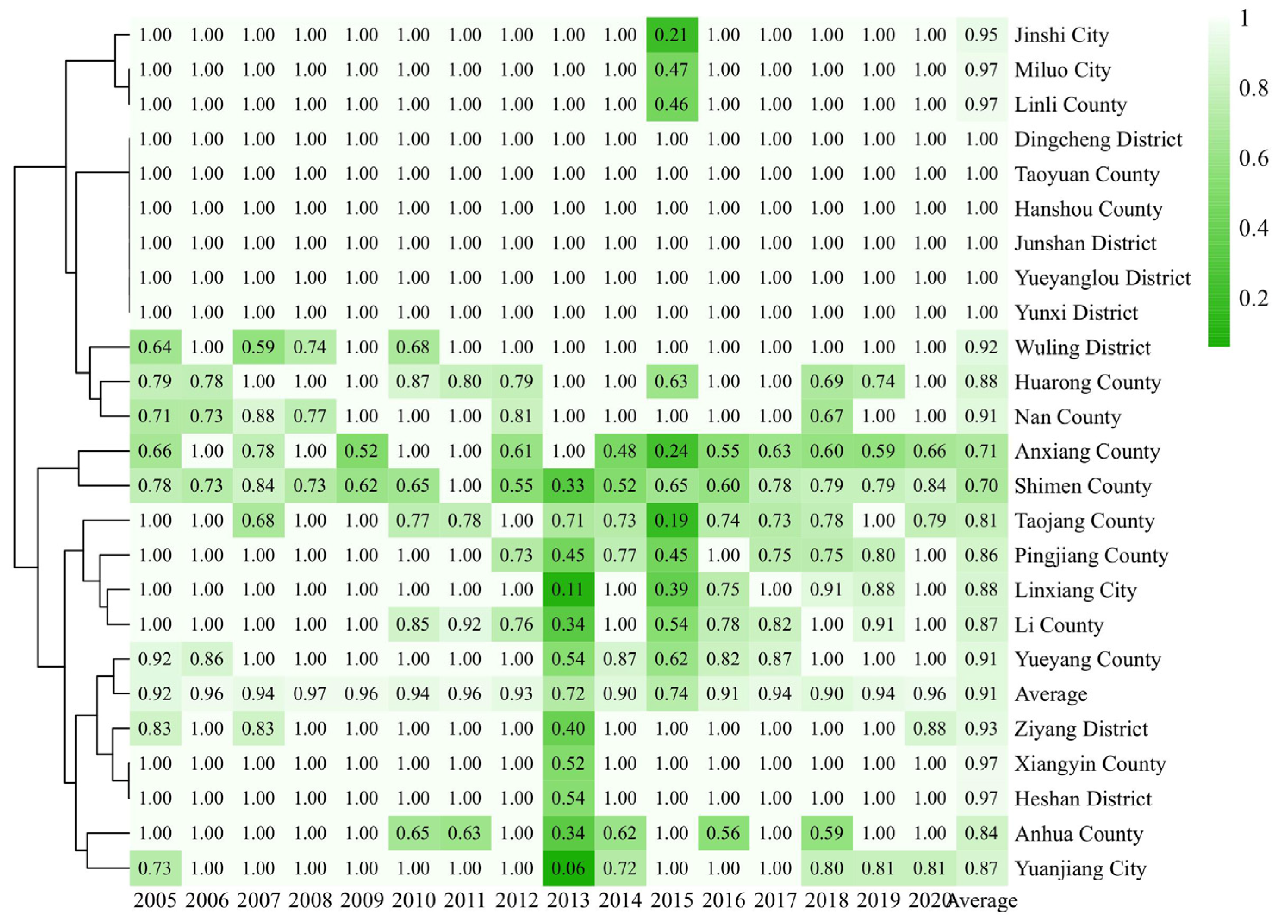


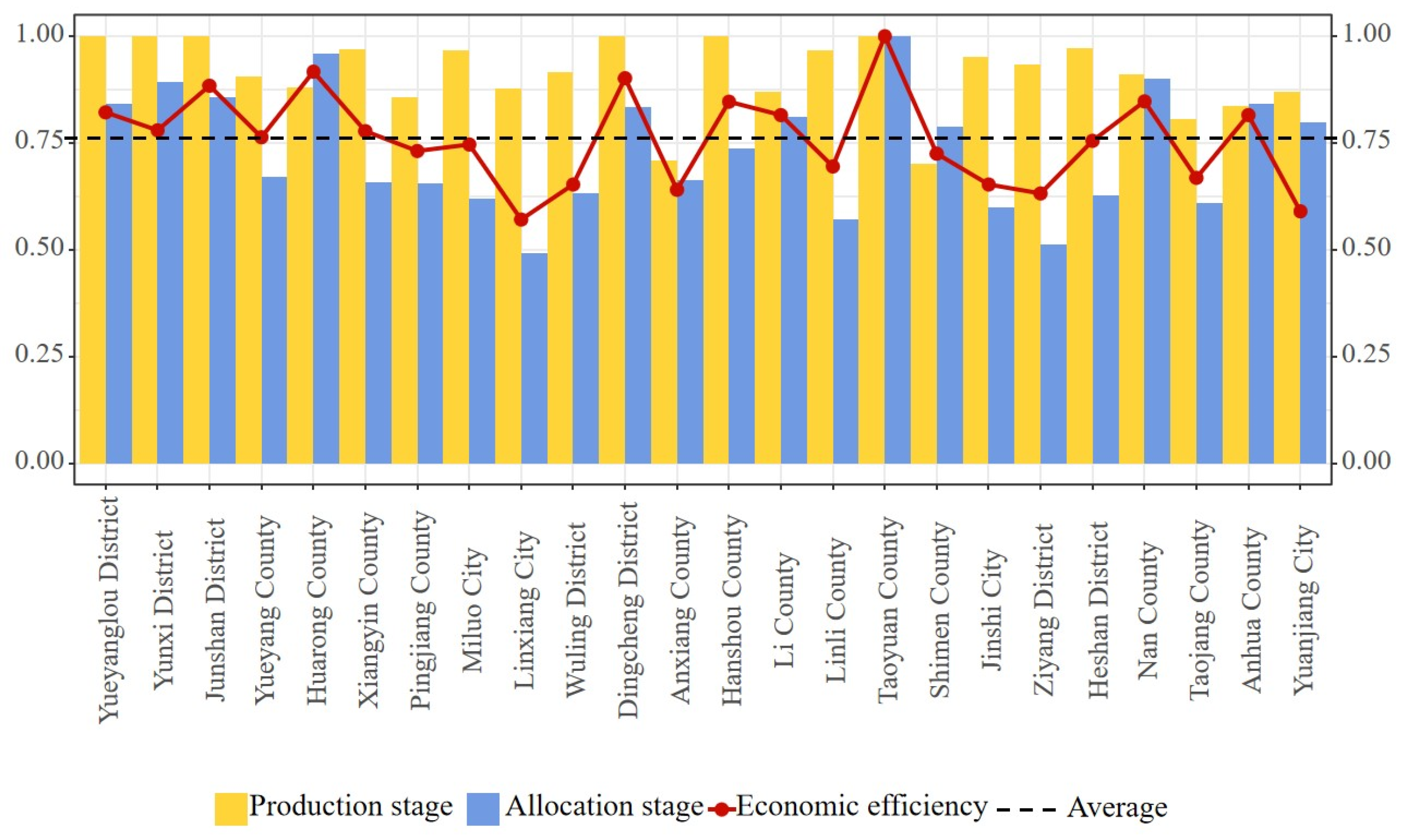
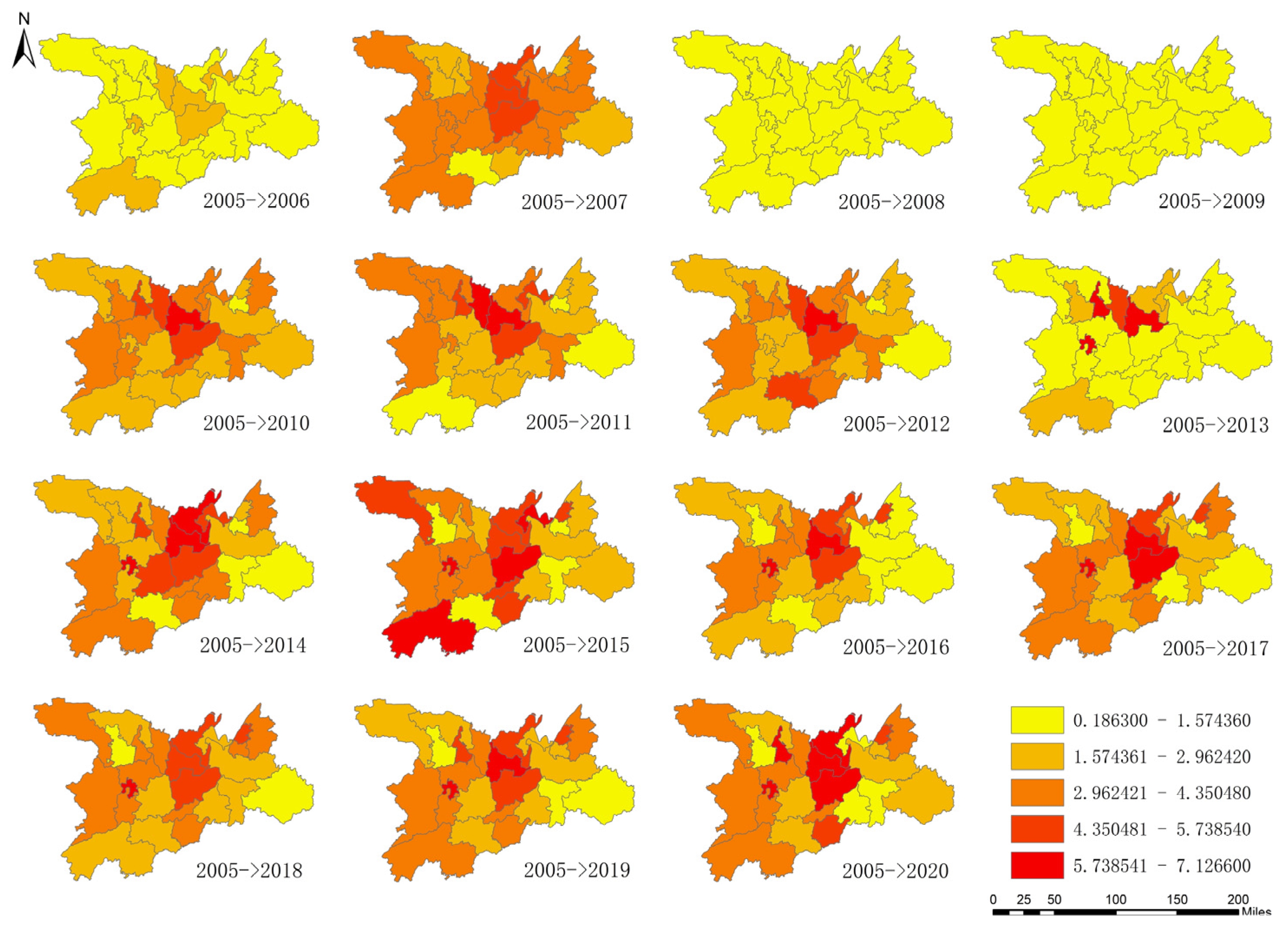
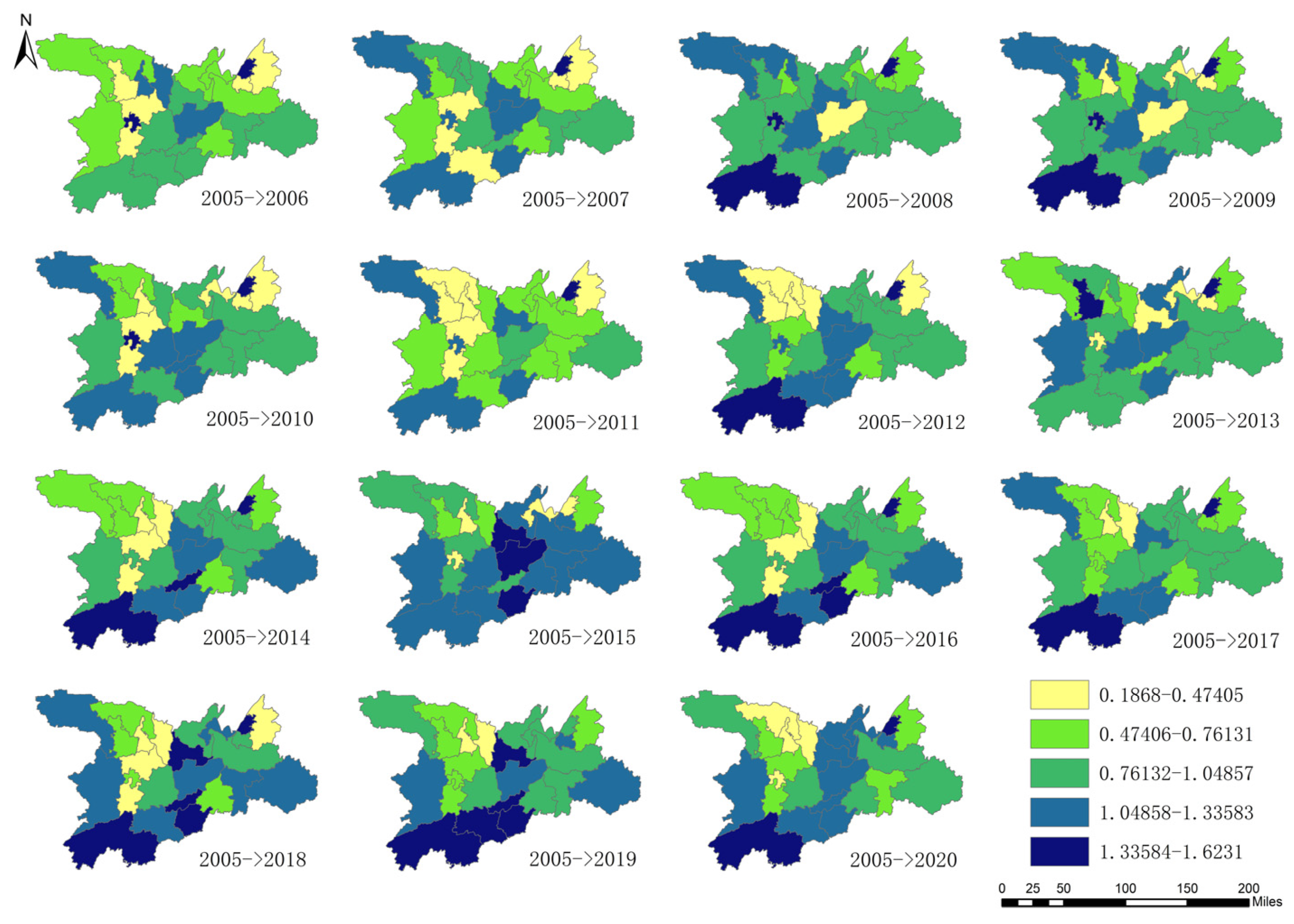
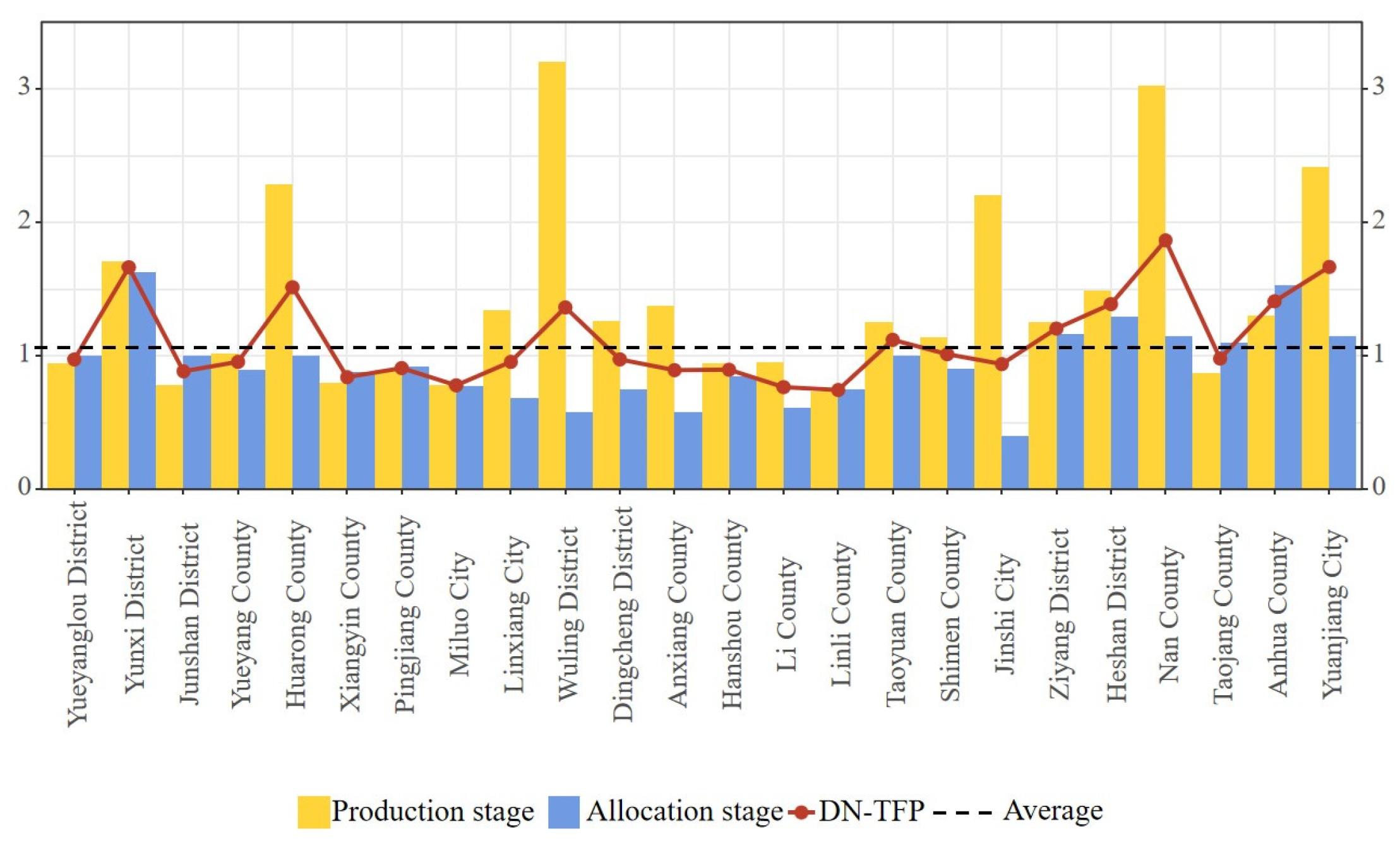
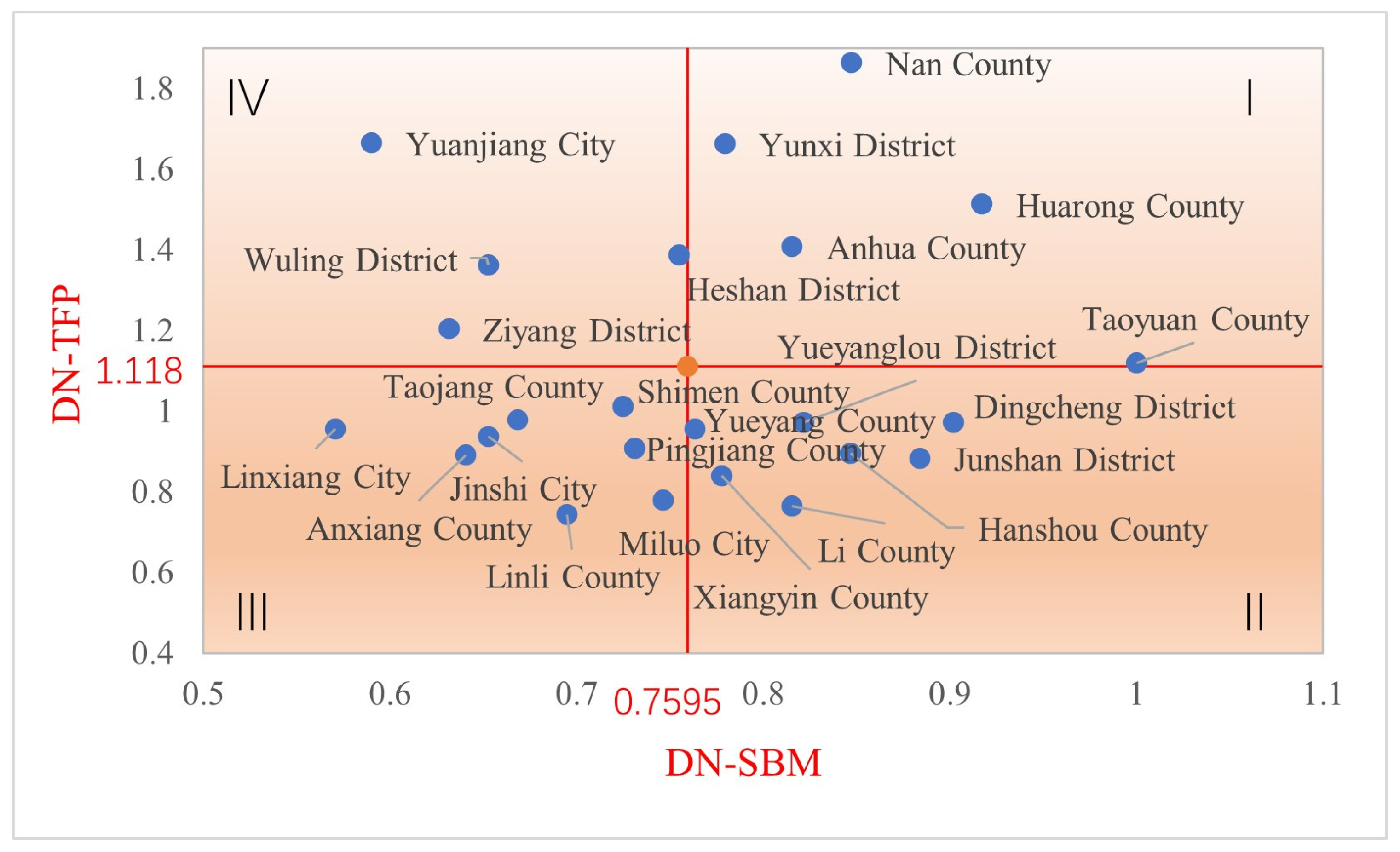

| Data | Variable | ||||
|---|---|---|---|---|---|
| Input | Input resource i to DMUj for division k at period t | Input slack | Slack of input i of DMUj for division k at period t. | ||
| Output | Output product r from DMUj for division k at period t | Output slack | Slack of output r of DMUj for division k at period t. | ||
| Link | DMUj from stage q to stage g at period t | Link slack | Slack of link of DMUj at period t. stands for free, as-input, and as-output. | ||
| Carry-over | Carry-over of DMUj at stage q from period t to period t + 1 | Carry-over slack | Slack of carry-over from period t to period t+1. | ||
| Intensity | Intensity of DMUj corresponding to stage q at period t | ||||
| Stage | Variable | Unit | Description |
|---|---|---|---|
| Production stage | (I) Agricultural labor | ten thousand people | The working-age population engaged in the production of agricultural goods or services for remuneration or profit. |
| (I) Total power of agricultural machinery | kilowatt (unit of electric power) | Total power mainly used for agricultural power machinery. | |
| (I) Crop sown area | thousand hectares | The area actually sown or transplanted with crops. | |
| (I) Fertilizer use | ton | Amount of fertilizer actually used for agricultural production. | |
| (L) Grain production | ton | The total amount of food produced by an agricultural producer during the calendar year. | |
| Allocation stage | (O) Value of agricultural output | ten thousand dollars | The value of the total product produced by the crop cultivation industry during the calendar year. |
| (C) Cropland area | thousand hectares | The area of a field that can be used for growing crops as well as for plowing. |
Disclaimer/Publisher’s Note: The statements, opinions and data contained in all publications are solely those of the individual author(s) and contributor(s) and not of MDPI and/or the editor(s). MDPI and/or the editor(s) disclaim responsibility for any injury to people or property resulting from any ideas, methods, instructions or products referred to in the content. |
© 2025 by the authors. Licensee MDPI, Basel, Switzerland. This article is an open access article distributed under the terms and conditions of the Creative Commons Attribution (CC BY) license (https://creativecommons.org/licenses/by/4.0/).
Share and Cite
Wang, Y.; Tang, J.; Wang, J.; Li, C. A Study on Integrating Production Efficiency and Allocation Efficiency into Economic Efficiency Based on the Value Chain—A Case Study of the Dongting Lake Region. Sustainability 2025, 17, 8490. https://doi.org/10.3390/su17188490
Wang Y, Tang J, Wang J, Li C. A Study on Integrating Production Efficiency and Allocation Efficiency into Economic Efficiency Based on the Value Chain—A Case Study of the Dongting Lake Region. Sustainability. 2025; 17(18):8490. https://doi.org/10.3390/su17188490
Chicago/Turabian StyleWang, Yao, Jie Tang, Jiaxin Wang, and Chunhua Li. 2025. "A Study on Integrating Production Efficiency and Allocation Efficiency into Economic Efficiency Based on the Value Chain—A Case Study of the Dongting Lake Region" Sustainability 17, no. 18: 8490. https://doi.org/10.3390/su17188490
APA StyleWang, Y., Tang, J., Wang, J., & Li, C. (2025). A Study on Integrating Production Efficiency and Allocation Efficiency into Economic Efficiency Based on the Value Chain—A Case Study of the Dongting Lake Region. Sustainability, 17(18), 8490. https://doi.org/10.3390/su17188490





